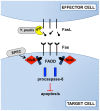Disruption of fas-fas ligand signaling, apoptosis, and innate immunity by bacterial pathogens
- PMID: 25101900
- PMCID: PMC4125287
- DOI: 10.1371/journal.ppat.1004252
Disruption of fas-fas ligand signaling, apoptosis, and innate immunity by bacterial pathogens
Conflict of interest statement
The authors have declared that no competing interests exist.
Figures

Similar articles
-
Many checkpoints on the road to cell death: regulation of Fas-FasL interactions and Fas signaling in peripheral immune responses.Results Probl Cell Differ. 2009;49:17-47. doi: 10.1007/400_2008_24. Results Probl Cell Differ. 2009. PMID: 19132321 Free PMC article. Review.
-
Distinct molecular mechanisms of Fas resistance in murine B lymphoma cells.J Immunol. 2000 Aug 15;165(4):1854-62. doi: 10.4049/jimmunol.165.4.1854. J Immunol. 2000. PMID: 10925264
-
Fas splicing variants and their effect on apoptosis.Adv Exp Med Biol. 1996;406:125-34. doi: 10.1007/978-1-4899-0274-0_13. Adv Exp Med Biol. 1996. PMID: 8910678 Review. No abstract available.
-
Distinct different sensitivity of Treg and Th17 cells to Fas-mediated apoptosis signaling in patients with acute coronary syndrome.Int J Clin Exp Pathol. 2013;6(2):297-307. Epub 2013 Jan 15. Int J Clin Exp Pathol. 2013. PMID: 23330016 Free PMC article.
-
[Immune evasion of human lung carcinoma cell A549 suppressed by human lymphoma cell Jurkat via Fas/FasL pathway].Zhongguo Fei Ai Za Zhi. 2010 Jul;13(7):681-5. doi: 10.3779/j.issn.1009-3419.2010.07.05. Zhongguo Fei Ai Za Zhi. 2010. PMID: 20673483 Free PMC article. Chinese.
Cited by
-
HIF1α-mediated TRAIL Expression Regulates Lacrimal Gland Inflammation in Dry Eye Disease.Invest Ophthalmol Vis Sci. 2020 Jan 23;61(1):3. doi: 10.1167/iovs.61.1.3. Invest Ophthalmol Vis Sci. 2020. PMID: 31995154 Free PMC article.
-
A Systematic In-silico Analysis of Helicobacter pylori Pathogenic Islands for Identification of Novel Drug Target Candidates.Curr Genomics. 2017 Oct;18(5):450-465. doi: 10.2174/1389202918666170705160615. Curr Genomics. 2017. PMID: 29081700 Free PMC article.
-
Chlamydia Infection Remodels Host Cell Mitochondria to Alter Energy Metabolism and Subvert Apoptosis.Microorganisms. 2023 May 24;11(6):1382. doi: 10.3390/microorganisms11061382. Microorganisms. 2023. PMID: 37374883 Free PMC article. Review.
-
Tumor-initiating stem cell shapes its microenvironment into an immunosuppressive barrier and pro-tumorigenic niche.Cell Rep. 2021 Sep 7;36(10):109674. doi: 10.1016/j.celrep.2021.109674. Cell Rep. 2021. PMID: 34496236 Free PMC article.
-
The anti-cancer effects and mechanisms of Scutellaria barbata D. Don on CL1-5 lung cancer cells.Oncotarget. 2017 Nov 27;8(65):109340-109357. doi: 10.18632/oncotarget.22677. eCollection 2017 Dec 12. Oncotarget. 2017. PMID: 29312612 Free PMC article.
References
-
- Suda T, Takahashi T, Golstein P, Nagata S (1993) Molecular cloning and expression of the Fas ligand, a novel member of the tumor necrosis factor family. Cell 75: 1169–1178. - PubMed
-
- Locksley RM, Killeen N, Lenardo MJ (2001) The TNF and TNF receptor superfamilies: integrating mammalian biology. Cell 104: 487–501. - PubMed
-
- Nagata S (1997) Apoptosis by death factor. Cell 88: 355–365. - PubMed
Publication types
MeSH terms
Substances
Grants and funding
LinkOut - more resources
Full Text Sources
Other Literature Sources
Medical
Research Materials
Miscellaneous

